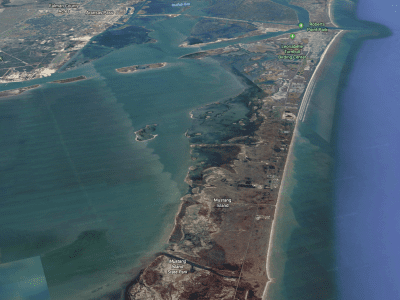Backbarrier flats – a relic coastal landform

Many years ago in travelling across coastal Texas I encountered washover fans. These extensive sand flats occurred behind Mustang and Padre barrier islands. They are formed by hurricane-driven storm surges that flow across the low islands into shallow lagoons. Armstrong-Price, Fisk and others have documented their morphology and sediment characteristics. They are contemporary features of the Texas coastal landscape. Stephen Leatherman edited a volume in 1981 on Overwash Processes (Hutchison Ross Publishing Company) containing many relevant papers.
On returning to Australia in the early 70s, it was soon apparent that similar but relic features occurred behind many sand barriers in NSW and Gippsland, in Victoria. I had completely overlooked them as landforms in my earlier work. An opportunity presented itself while employed at ANU and later at RMC, Duntroon, to map, drill and date what I then termed backbarrier flats and to seek to explain their origin. The modern analog from Texas was a starting point.
In some respects backbarrier flats are quite prominent features. Driving down the NSW south coast recently to Merimbula, I was reminded of how roads follow the relatively smooth and direct path of a backbarrier flat. Good examples occur at Wairo Beach south of Ulladulla and between Merimbula and Pambula. In the latter case, the Merimbula airport is sited on the flat. During my drilling period, I had examined similar features in the Shoalhaven area, around Anna Bay north of Newcastle, and especially the relic deposits north of Hawks Nest. Much later it was possible to study them behind Ninety Mile Beach at Gippsland. Generally these surfaces are 1-2m above high water levels.
They were fascinating for a number of reasons. I could not discover a contemporary equivalent of washover fans in these locations. They appear to date from mid-Holocene, at a time just prior to the progradation of strand plains (prograded bay barriers), or the more massive accumulation of aeolian sand on top of nearshore sands that made up so-called stationary bay barriers. Thus their morpho-stratigraphic story involved deposition during the late phase of marine transgression into a particular embayment followed by extensive overwash sediments that constitute the slightly dipping landwards sand plain to the rear of the barriers.
In several publications involving a range of authors, I was privileged to describe the nature of backbarrier sedimentation. An example was in our initial study of Holocene age structure of sand barriers published in 1978 as a report of the Geography Department, Faculty of Military Studies, UNSW. Here we interpreted the stratigraphic pattern from our drill holes at Merimbula near the airport. The transgressing sea entered the embayment about 8000 years ago as a receding beach. Washover deposits accumulated behind the beach as a low relief beach-dune system that accumulated near vertically as a stationary barrier blocking off a lagoon. After sea level reached around its present position c.6000 years ago, washover processes became less active. By 5000 years ago the barrier had reached sufficient height not to be over-topped by surging waves. The flat then became a relic, well-vegetated landform. This general sequence was repeated in several locations although the lateral and vertical dimensions of the sand units that make up the backbarrier, nearshore and beach-dune deposits can vary, as does the occurrence of muds nearer the lagoons that have formed behind the barriers.
The importance of washover processes in the accumulation of heavy mineral placers became obvious to me in the mid-1970s when inspecting sand mining pits near Anna Bay and Hawks Nest. Landward dipping lenses of rutile and zircon were exposed in these pits dug into the low-relief flats just above present sea level. This contrasted to the sedimentary structures found in beach deposits to seaward. Peter Roy in 1999, in a brilliant synthesis of the nature and genesis of placers in southeast Australia, related these upper level concentrations on the backside of accretionary barriers to events occurring at the end of the marine transgression (Economic Geology, v.94).
To me accumulations at or near the top of the transgressive units that make up backbarrier deposits indicates a period of high wave energy at the beachface allowing reworking of sands and heavy mineral landwards. This could occur during extreme events that permit storm surges to penetrate up to a kilometre inland. I think of this as a high-energy “window” that was open for only a short period of around 500-1000 years after the stillstand was reached. The window closed once dune formation and progradation took over as surplus sand in the nearshore zone was transferred into accretionary beach-dune ridges or high foredunes. Whether or not sea level changes were a factor in this morphodynamic switch of conditions is an open question.
Bruce Thom
Words by Prof Bruce Thom. Please respect the author’s thoughts and reference appropriately: (c) ACS, 2018, posted 2 December 2018, for correspondence about this blog post please email austcoastsoc@gmail.com
#125


 NSW 2019 Coastal Conference – Terrigal
NSW 2019 Coastal Conference – Terrigal